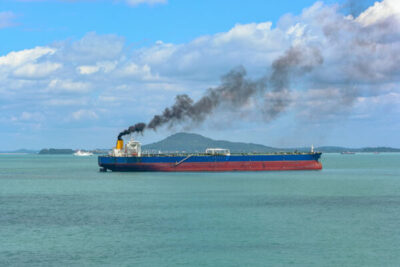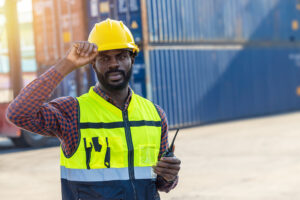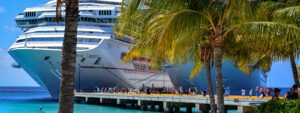Getting to zero
By Jan Sierhuis
The concept ‘smart port’ describes the application of ‘smart’ Information and Communications Technology (ICT) to make ports more cost-efficient. With the heightened global push for ‘greener shipping’ and the energy transition away from fossil fuels, the word ‘green’ is now often mentioned in discussions or documentation pertaining to a seaport’s development plans to achieve efficiency, resilience and sustainability. As cargo and cruise lines reduce carbon emissions throughout the ‘life cycle’ of their ships, at sea and while in port, they are looking to partner with ports interested in creating ‘green corridors’.
The ‘Getting to Zero Coalition’ aims to establish at least six such corridors by 2025 and many more by 2030. The idea is that the rest will follow in the period between 2030 and 2050. A ’Green Corridor’ is a targeted shipping lane between two transportation points, where the entire logistics chain, both shipside and portside, is fuelled by renewable and sustainable energy.
Caribbean context
 Carbon emissions in the Latin and Caribbean region increased by 3% between 2010 and 2019, according to recent studies carried out by the Economic Commission for Latin America and the Caribbean (ECLAC) and the Inter-American Development Bank (IDB). Over 95% of Caribbean energy comes from traditional carbon derivatives. And ‘maritime emissions’ are between 20-40% of total emissions. Adrian Beharry, assistant professor of practice, maritime economics at the University of Trinidad & Tobago (UTT) remarks to Portside Caribbean : ”The Caribbean is a net carbon contributor. With energy prices soaring, and with the existing dependency on tourism and agriculture, a new Caribbean energy future is needed to remain competitive.” Becoming greener, however, poses challenges, particularly for the Small Island Developing States (SIDS). Most lack the required public funding, human resources and technology access required to become a sustainable smart port. Regional funding and regulating agencies like IMO, EU, IDB and CDB have teamed up to guide regional governments through the process and assist with capacity building, technology transfer and funding mechanisms. A regional overview is provided in this article.
Carbon emissions in the Latin and Caribbean region increased by 3% between 2010 and 2019, according to recent studies carried out by the Economic Commission for Latin America and the Caribbean (ECLAC) and the Inter-American Development Bank (IDB). Over 95% of Caribbean energy comes from traditional carbon derivatives. And ‘maritime emissions’ are between 20-40% of total emissions. Adrian Beharry, assistant professor of practice, maritime economics at the University of Trinidad & Tobago (UTT) remarks to Portside Caribbean : ”The Caribbean is a net carbon contributor. With energy prices soaring, and with the existing dependency on tourism and agriculture, a new Caribbean energy future is needed to remain competitive.” Becoming greener, however, poses challenges, particularly for the Small Island Developing States (SIDS). Most lack the required public funding, human resources and technology access required to become a sustainable smart port. Regional funding and regulating agencies like IMO, EU, IDB and CDB have teamed up to guide regional governments through the process and assist with capacity building, technology transfer and funding mechanisms. A regional overview is provided in this article.
Smart Port Manual
ECLAC and IDB have done much research on smart ports and the energy transition in the LA/C context. The IDB ‘Smart Port Manual’ is a useful tool, available for download at www.publications.iadb.org/publications.
 The manual helps port authorities and terminal operators to monitor the process of transformation to a smart port. Based on international best practices, the text describes initiatives and includes a list of quantitative and qualitative indicators to track and score progress. It also provides a ‘green port’ concept to ensure the highest level of efficiency, security, social inclusion, resource conservation, and environmental protection. ‘Green ports’ integrate environment-protection strategies into their operations and in their interaction with other stakeholders, including terminal operators, shipping lines and neighbouring communities. The manual also describes how green ports can create ‘value’ and what are the options for ‘ownership structure’ and ‘operational models’.
The manual helps port authorities and terminal operators to monitor the process of transformation to a smart port. Based on international best practices, the text describes initiatives and includes a list of quantitative and qualitative indicators to track and score progress. It also provides a ‘green port’ concept to ensure the highest level of efficiency, security, social inclusion, resource conservation, and environmental protection. ‘Green ports’ integrate environment-protection strategies into their operations and in their interaction with other stakeholders, including terminal operators, shipping lines and neighbouring communities. The manual also describes how green ports can create ‘value’ and what are the options for ‘ownership structure’ and ‘operational models’.
Barriers
Several ‘barriers’ to becoming a smart port are identified in the IDB manual. These include ‘governance and funding models’, ‘social rejection’ and a ‘technology challenge’ with a lack of qualified personnel. In many cases, implementation of smart technologies requires significant investment in port ‘infra & info’ structure. Here there is a wide gap between larger international ports and smaller to medium-sized ports in the Caribbean region. Barriers can be overcome by prioritizing projects and using incentives, funds and available aid for innovation.
 The fear of ‘technology replacing people’ can be countered when new trends are presented by showing data on the number of tech jobs that will be created in the process. Ports can develop test concepts and pilot programmes to verify if a technology is valid and accepted. Universities and technology centres, regulating and funding agencies, governments and local stakeholders are required to participate in pilot projects to make any acceptable transition.
The fear of ‘technology replacing people’ can be countered when new trends are presented by showing data on the number of tech jobs that will be created in the process. Ports can develop test concepts and pilot programmes to verify if a technology is valid and accepted. Universities and technology centres, regulating and funding agencies, governments and local stakeholders are required to participate in pilot projects to make any acceptable transition.
IMO assistance
The International Maritime Organisation (IMO) has teamed up with governments and entities in the Caribbean region to assist in making the transition to a ‘smart port’. One vehicle for delivering this assistance is the Maritime Technology Cooperation Centre (MTCC). The MTCC is part of the Global MTCC Network (GMN) project with The University of Trinidad and Tobago as host institute. The first phase was funded by the European Union and closed in 2021.
Project leader Vivian Rambarath-Parasram said that during this phase a regional fuel consumption data collection system was setup, allowing the monitoring of Marpol VI compliance of vessels trading in the Caribbean. Other relevant IMO projects include the GLOMEEP in Jamaica, which provides ‘toolkits’ for port emissions inventories and maritime decarbonization. And the Norway-funded ‘GreenVoyage2050’ project is setting up a National Action Plan for Belize to address carbon emissions from shipping and draft legislation. “Notwithstanding all these efforts, much remains to be done”, Rambarath-Parasram said. “What we need is a coherent government strategy on maritime decarbonization to be included in national roadmaps for a sustainable blue economy. This would really open the sector for outside funding and allow regional ports and partners to team up and make the necessary transition”, she said in summing up the regional challenge. To speed the process, the IMO’s CARIBSMART project is underway, laying the foundations to facilitate the legislative transformation process across the Caribbean region.
Other developments
In Curaçao, local cooperation between several public and private entities from Curaçao and the Netherlands, led to the establishment of a so-called ‘Living Lab’ to address challenges related to energy transition. Partners in this venture include the University of Curaçao (UoC), the Dutch TNO Technology Research Institute, the Curaçao Port Authority (CPA), refinery owner Refineria di Kòrsou (RdK), and several public entities, including the local utilities, fuel distribution, bus and waste-collection companies. From the Netherlands, tech company VDL , storage company Vopak, offshore company Van Oord, Port of Rotterdam and Damen Shipyard participate. Pilot projects include the ‘electrification’ of the public transport system, including buses, passenger ferries and Curaçao’s iconic diesel-operated pontoon bridge. Maritime projects include the conversion of sargassum into energy and ‘value’ products, and the ‘electrification’ of local tug and pilot boats by supply of ‘green shore power’. The Living Lab will be an open ecosystem where innovations are tested on a relatively small scale The idea behind the project is that supply chain innovations can be established more quickly on an island scale, and should they turn out to be successful, they can also be rapidly scaled up. The set-up of a ‘Hydrogen Value Cluster’ is foreseen, which would use hydrogen-based technologies for decarbonizing energy systems.
Funding
The Caribbean Development Bank (CDB). recognises the unique contribution of the port sector to development of the Caribbean Region and is focussed on supporting the sustainable and future-ready development of Caribbean ports through digital transformation and the transition to renewable energy.
he CDB assists with international funding of targeted sustainable projects for its Borrowing Member Countries (BMCs). William Ashby, Portfolio Manager of the CDB’s Economic Infrastructure Division, indicated that energy intensive port activities depending on fossil fuels are increasingly targeted for ‘electrification’. For some small Caribbean ports, transformation of national electricity supply systems to Renewable Energy (RE) sources seems a more effective solution as compared to port-installed generation. For example, to facilitate possible future services such as ‘cold ironing’, also referred to as shore power. Since 2015, the CDB has been promoting renewable energy (RE) and seeking to assist its BMCs to make the shift to replace their petroleum-based national grids with RE options.
Joseph Williams, Coordinator of the Sustainable Energy Unit indicated that the two RE sources targeted by CDB, are ‘solar energy’ and ‘geothermal energy’ (GE), with ‘offshore’ wind seen as the next big RE frontier for the Caribbean. GE potential is large in the Eastern Caribbean. It has the potential to transform not just electricity generation but also the national economies of lands that are of volcanic origin. Given the complexity and high technical risk associated with GE projects, the CDB has developed a GeoSmart Initiative to support GE development in applicable territories. In that initiative, the CDB provides facilities such as (contingent grants and concessional loans to de-risk the projects and facilitate a Public-Private Partnership approach, where private partners provide equity, expertise and experience. In this regard, the CDB has financed drilling operations in St. Vincent and the Grenadines and is funding preparatory activities in three other its borrowing countries.
Sustainable cruising
The cruise industry embarked on a massive decarbonisation programme and is looking for ‘partner ports’ as suppliers of decarbonized bunkers and shore power, or other emission-related services. The building of ‘cleaner’ cruise ships requires low vanadium fuels, LNG and other alternative energy sources.
 Given the carbon footprint for liquifying natural gas, the industry seems to view LNG more as a ‘transitional’ energy source. In a bold move, Carnival Corporation recently invested in ‘biofuel’ for its new German-based AIDAprima. It is made from 100% sustainable raw materials with no link to land-use competition or deforestation. Such ships will not ply Caribbean waters immediately but, as the technology and market develop, they might in the near future. Sibrand Hassing, Director of Fleet Operations for HAL Europe, commented to Portside Caribbean that its mother company Carnival Corp & plc, of which HAL is a part, is using already LNG as a ‘transitional’ fuel and currently looking at biofuels, hydrogen and fuel cells as likely alternatives. The company also embarked on an active shore power strategy and seems prepared to pay ‘a price’ for this to help recover initial investments in port infrastructure, stated Sibrand Hassing.
Given the carbon footprint for liquifying natural gas, the industry seems to view LNG more as a ‘transitional’ energy source. In a bold move, Carnival Corporation recently invested in ‘biofuel’ for its new German-based AIDAprima. It is made from 100% sustainable raw materials with no link to land-use competition or deforestation. Such ships will not ply Caribbean waters immediately but, as the technology and market develop, they might in the near future. Sibrand Hassing, Director of Fleet Operations for HAL Europe, commented to Portside Caribbean that its mother company Carnival Corp & plc, of which HAL is a part, is using already LNG as a ‘transitional’ fuel and currently looking at biofuels, hydrogen and fuel cells as likely alternatives. The company also embarked on an active shore power strategy and seems prepared to pay ‘a price’ for this to help recover initial investments in port infrastructure, stated Sibrand Hassing.
The future is now
Caribbean states have limited access to hardware, software and human capital, the required ingredients for a smart energy transition. Furthermore, regional ports cannot make this transition alone. a targeted government strategy that includes all local and national stakeholders is needed to assist the ports to create the necessary partnerships and to access the required funding from outside sources. The good news is that regional assistance is available and investors are looking for dedicated ‘testing environments’. []
- First published December 1, 2022






